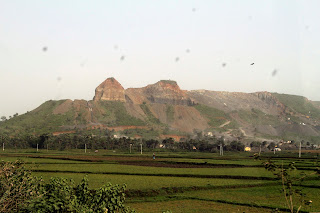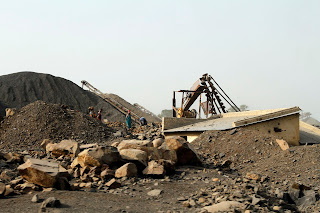The
Silent Cry of Rajmahal Hills
By Ashok Karan
While
travelling through the remote stretches of the Rajmahal Hills in
Sahebganj district, Jharkhand, I was struck with dismay. What greeted my eyes
was not the pristine beauty of nature, but the scars of unchecked stone
crushing and quarrying. Once a natural marvel, the hills are now rapidly losing
their identity to the booming construction industry.
The
hills—rich in geological heritage—are being mined relentlessly to produce
building materials, including the widely used “Pakur Chips”.
As shared by journalist Brajesh Verma ji, these chips are extensively
used in Jharkhand, Bihar, and parts of West Bengal, especially in railway and
road infrastructure projects.
But behind
this development lies a deeper concern: the existential threat to the
indigenous Suriya Paharia community, classified as a Particularly
Vulnerable Tribal Group (PVTG). For generations, they have lived in harmony
with nature—depending on mixed farming, forest produce, and mountain streams.
Now, they find their way of life disintegrating due to the regular blasting of
hills, which causes intense vibrations, air pollution, and even rocks falling
dangerously close to their homes.
Villages
like Alwa, Amjola, Gurmi, Pangdo, Dhokuti, Bekchuri, and Malto
are scattered across the hills, each home to sparse but resilient populations.
In Malto village alone, about 30 Suriya Paharia households are struggling to
cope with drying streams, falling groundwater tables, and shrinking forest
resources.
One elderly
tribal man shared, “Living near the hills was once a matter of pride. Now it’s
a daily struggle.”
What’s even
more alarming is the ecological and scientific significance of the
Rajmahal Hills. Experts believe these hills, stretching over 2,600 sq. km,
date back between 68 to 118 million years, making them among the oldest
in India—next perhaps only to the Aravallis. Rich fossil deposits embedded in
these hills are invaluable for scientific research, yet remain under threat due
to rampant mining.
Despite some
government initiatives to preserve the fossil heritage, the region remains
overwhelmed by mining activity. In Sahebganj district alone, there are
around 180 legal mines and over 450 stone crushers—with widespread concerns
about illegal operations.
This isn’t
just a tribal issue. It’s an environmental crisis. Once a hill or
mountain is destroyed, it’s lost forever. No amount of reconstruction or
compensation can bring it back.
As I
journeyed through the Rajmahal range, I saw not just machines and crushers, but
a silent warning: if we continue to exploit our natural heritage so
mercilessly, the cost will be unbearable for future generations.
Let us not
wait until it’s too late.
In
Pictures:
1.
Rajmahal
Hills stripped bare by mining.
2.
Stone
crushers at work in the Rajmahal region.
📷 & ✍️ Text
and Photos by Ashok Karan
🔗 ashokkaran.blogspot.com
#RajmahalHills
#TribalRights #EnvironmentalJustice #FossilHeritage #StopIllegalMining
#SuriyaPaharia #SustainableDevelopment #Jharkhand #SaveOurHills #EcoCrisis
#VoiceForNature #AshokKaranReports
Let’s raise
our voices. Please like, share, and subscribe to support
this cause.




Leave a Reply